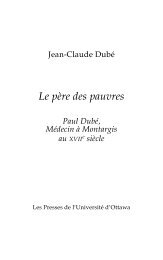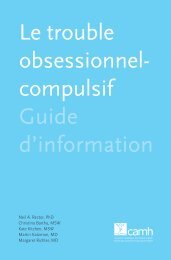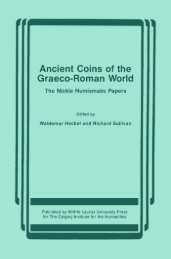Hilaire Kallendorf
Hilaire Kallendorf
Hilaire Kallendorf
Create successful ePaper yourself
Turn your PDF publications into a flip-book with our unique Google optimized e-Paper software.
Exorcism and Its TextsSubjectivity in Early ModernLiterature of England and Spain<strong>Hilaire</strong> <strong>Kallendorf</strong>UNIVERSITY OF TORONTO PRESSToronto Buffalo London
www.utppublishing.comUniversity of Toronto Press Incorporated 2003Toronto Buffalo LondonPrinted in CanadaISBN 0-8020-8817-1Printed on acid-free paperUniversity of Toronto Romance SeriesNational Library of Canada Cataloguing in Publication<strong>Kallendorf</strong>, <strong>Hilaire</strong>Exorcism and its texts: subjectivity in early modern literature ofEngland and Spain / <strong>Hilaire</strong> <strong>Kallendorf</strong>.(University of Toronto romance series)Includes bibliographical references and index.ISBN 0-8020-8817-11. Demoniac possession in literature. 2. Exorcism in literature.3. English literature — Early modern, 1500-1700 - History and criticism.4. Spanish literature - Classical period, 1500-1700 - History andcriticism. I. Title. II. Series.PR149. D47K342003 809'. 9337 C2003-903627-8Permission is gratefully acknowledged to reprint parts of chapters 1, 4, and 5 from thefollowing:'Exorcism and the Interstices of Language: Ruggle's Ignoramus and the Demonizationof Renaissance English Neo-Latin. ' From Acta Conventus Neo-Latini Cantabrigiensis:Proceedings from the Eleventh International Congress of Neo-Latin Studies, edited byRhoda Schnur, MRTS vol. 259 (Tempe, AZ, 2003). Copyright Arizona Board ofRegents for Arizona State University.'Intertextual Madness in Hamlet: The Ghost's Fragmented Performativity, 'Renaissance and Reformation / Renaissance et Réforme 22.4 (1998): 69-87.'The Diabolical Adventures of Don Quixote, or Self-Exorcism and the Rise of theNovel, ' Renaissance Quarterly 54. 1 (2002): 193-223.University of Toronto Press acknowledges the financial assistance to its publishingprogram of the Canada Council for the Arts and the Ontario Arts Council.University of Toronto Press acknowledges the financial support for its publishingactivities of the Government of Canada through the Book Publishing IndustryDevelopment Program (BPIDP).
To my husband CraigVide quam mihi persuaserim te me esse alterum.- Cicero, ad Familiares 7. 5
ContentsAcknowledgments xiPrologue — A Force Within: The Importance of Demonic Possession for Early ModernStudies xiiiA Paradigm of Theologemes for Literary Exorcism xxiIntroduction: The Morphology of Exorcism, or a Grammar of Possessionin Spanish and English Literature, 1550—1700 31 Demoniacs in the Drama: Theatricalities of Comic Possession and theExorcism of the Body Politic 17The Demon Enters the Body: Alonso de la Vegas La duquesa de la rosa 19Symptoms of Possession: Jonson's The Devil is an Ass 23Demonic Polyglossia: Ruggle's Ignoramus 26The Coach: Jonsons Volpone 29The Exorcist: Shakespeare's Twelfth Night 33The Lovers' Ruse: The Bugbears 35The (Mock) Exorcism: Shakespeare's Comedy of Errors 39Binding the Body: Timoneda's Los menemnos 44Relics, Holy Water, and Other Props: Shadwell's The Lancashire Witches 48The Successful Exorcism: El pleyto que tuvo el diablo 51
viiiContentsExorcizing the Body Politic: Zamora's El hechizado por fuerza and Middleton'sThe Phoenix 562 Possessed Pícaros and Satanic Satire 67An Erasmian View of Lazarillos Fifth Tratado 68Another Pícaro and Another Alguacil endemoniado: Quevedo's Buscón, Sueños,Satirical Poetry, and La endemoniada fingida 75Alguacil endemoniado or Demonio alguacilado? 79'The Experienced Mysteries of Damnation' 81'Da... al discurso miedo': The Printing of Forbidden Knowledge 89'Libido sciendi' 923 Romance, the Interlude, and Hagiographical Drama: The Humanizationof Possession and Exorcism 97Romance, the Interlude, and the Restoration of Order: Cervantes' Persiles andLope's La endemoniada 99Rebirth and Hagiography: Cervantes' El rufián dichoso 104'False Miracles and Apocryphal Things': Cervantes and the Debate over theComedia de santos 113Saint = Exorcist: Calderón's Las cadenas deldemonio and Lope's El divinoafricano 1174 Tragedy As the Absence or Failure of Exorcism 126The Relationship of Satire to Tragedy: Harsnett's Declaration 127Exorcism as Neo-Aristotelian Catharsis: King Lear 131The Demon As Scapegoat: A Yorkshire Tragedy, with a Note on Othello andMacbeth 140Tragedy, Possession, and Performativity: Hamlet 1495 Self-Exorcism and the Rise of the Novel 157Poltergeists and Wizards: Supernatural Pranks in Part I of Don Quijote 158Mysterious Caves and Flying Horses: Diabolical Humour in Part II ofDon Quijote 165Lucid Intervals and a Wise Enchanter: Demonic Possession in DonQuijote 167The Paradox of Self-Exorcism 176Self-Exorcism and the Rise of the Autonomous Novelistic Character 180
ContentsixConclusion: Liturgy in Literature, or Early Modern Literary Theory and theChristian Legitimate Marvellous 184Epilogue: Problematizing the Category of 'Demonic Possession' 200Notes 207Bibliography 265Index 307Illustrations follow p. 138
AcknowledgmentsI would like to express gratitude to the Renaissance Society of America for aresearch grant and to the UCLA Center for 17th and 18th Century Studies for anAhmanson-Getty Postdoctoral Fellowship, which allowed me the leisure to revisethis manuscript. I would also like to thank the editors of Renaissance Quarterly,Renaissance and Reformation I Renaissance et Réforme, and Acta Conventus Neo-Latini Cantabrigiensis: Proceedings of the Eleventh International Congress of Neo-Latin Studies for permission to incorporate into this book material from articlespublished first in those venues. My heartfelt thanks go to Dr Miriam Skey of theUniversity of Toronto Press for her careful copy editing of the manuscript.On the personal level, my debts are more numerous. I would like to thank myparents for giving me life, my husband for giving me love, and my son for beingthis book's 'twin. ' To my thesis director, mentor, and friend Alban Forcione gomy warmest thanks and appreciation. To Tony Grafton I offer most sincerethanks for doing much more than you had to (and let's have another beer at theHispanic Society sometime). To Ron Surtz, well, what can I say? You are a 'fullservice' DGS.... To Douglas Brooks for reading part of the manuscript and forbeing the best colleague I could hope to have. Thanks also to Meg Greer for hergenerous hospitality. To Bob Hollander for the smell of his pipe. To Carol Szymanskifor the butterflies. And to God for sending me a guardian angel to protectme from all the demons!
HORATIO: O day and night, but this is wondrous strange!HAMLET: And therefore as a stranger give it welcome.There are more things in heaven and earth, Horatio,Than are dreamt of in your philosophy.(Hamlet 1.5.164-7)
Prologue - A Force Within:The Importance of Demonic Possessionfor Early Modern StudiesWhy should demonic possession matter to all students and scholars of the earlymodern period? One answer - and, I believe, the most important one - is thatpotential possession by a demon both threatened and enhanced the integratednotion of selfhood which scholars from Jacob Burckhardt to Stephen Greenblatthave pointed to as a hallmark of the Renaissance. This early modern attention tothe self and the individual identity has been contrasted broadly with the medievalinsistence on anonymity: the emphasis in medieval manuscripts copied by anonymousscribes was on what was being said, not on who was saying it. Thus medievalliterature was largely communal or anonymous (at least by conventionaldistinction), while the new-found preoccupation with authorship may be understoodto be linked closely with the advent of the printing press and the economicconcept of private ownership. 3The idea of a coherent self is central to emergent notions of individuality andsubjectivity in the early modern period.4 From Montaigne and Machiavelli toCastiglione and Queen Elizabeth, early modern people carefully fashioned andscrutinized both their private selves and their public images.5 It is only logicalthat any external force, supernatural or otherwise, which was perceived as a possiblethreat to — or enhancement of— the self was potentially viewed with extremeinterest combined with at least moderate (if not hysterical) alarm.Demons were a threat to the self in that they were believed by some to have theability to take over a persons identity - body, mind, and soul. As Nancy Caciolaasserts: 'It is the primal ability of the body to maintain its borders, to recognizethe self and keep other things out, that defines identity';6 when this ability is lost,as in the case of demonic possession, then so is identity. For this reason, exorcismsaddressed individual adjurations to each body part, sealing them against
xivPrologue: A Force Withindiabolical incursion. 7 In fact, the idea of identity was so inextricably bound upwith notions of possession that the early modern self, in the face of a demon,could fear 'the total transformation of her own essence, rather than the integrationof a supplemental spirit into her heart or soul. ' 8 In this sense, demonic possessioncould mean a complete loss of, or change of, identity. The possessedperson could even conceivably fluctuate between identities as a result of thedemon's inconstant visitations: 'the devil's mark is a cloud gliding through theflesh in an "inconstant" manner, a text erasing itself and rewriting itself at random.' 9Once inside a person, what else could a demon do? The Inquisitors HeinrichKramer and James Sprenger, in their infamous Malleus maleftcarum, assert thatdevils can, with God's permission, enter our bodies; and they can then make impressionson the inner faculties corresponding to the bodily organs. And by thoseimpressions the organs are affected in proportion as the inner perceptions areaffected in the way which has been shown: that the devil can draw out some imageretained in a faculty corresponding to one of the lenses; as he draws from the memory,which is in the back part of the head, an image of a horse, and locally moves thatphantasm to the middle part of the head, where are the cells of imaginative power;and finally to the sense of reason, which is in the front of the head. 10This passage describes the demons' use of the sense of sight to torment their victims.Demons could also take over a person's hearing: Victims are often unable tohear the priest's words because the devil is whispering, mumbling, or screamingin their minds.'11 In other words, demons are like an 'invisible miasma'12 whichinfect the inner faculties, the bodily organs, the memory and imagination, andfinally even the seat of reason. Harold Skulsky has compared metaphors of cannibalismwith metaphors of demonic possession and concluded that they bear somestriking similarities: 'the would-be "demon's" wish dream of parasitism is thewould-be "cannibal's" nightmare of taking in a parasite - of finding oneselfthe container of something malignant, intelligent, and alive. '13 Caciola describesdie experience of demonic possession with sensitivity and detail:This literal sense of physical openness within the interior of the body - like a networkof interconnected caverns criss-crossing beneath the surface of the earth - leadsto a vision of the demon hibernating inside the human body as an animal might livewithin a cave. Yet this incursion is disruptive and violent, the cause of torments: thesurface imprint of possession displays the interior penetration of the body in somaticchanges such as bloating, boils, or convulsions... [T]he original spirit of the victimremains within the body, but it is as if held captive, surrounded by demonic influ-
Prologue: A Force Withinxvences that do not allow it to access its... senses or to control its limbs. This sense ofspirits playing at hide-and-seek within the caverns of the body also is elaborated symbolically...14This picture of the early modern self as 'porous or frangible'15 to demonic penetrationis unambivalent in its consequences: demons could eliminate free will andmake a person less than responsible for his or her actions.On the other hand, demons were a potential enhancement to the self becauseof the revival during this time period of ancient Greek notions of prophecy andpoetic frenzy. 16 Socrates had a daimon who advised him on weighty matters ofphilosophy, and Neoplatonists such as Marsilio Ficino, Tommaso Campanella,and Giordano Bruno, citing ancient precedents, revived the hermetic traditionand practice of 'white' or beneficial demonic magic.17 This magic, often connectedto astrology and frequently leading to charges of heterodoxy by ecclesiasticalofficials, was a synthesis of several competing traditions. As this white or'angelic' magic was practised by such early modern magi as Cornelius Agrippaand John Dee, it invoked daemones who were ambiguous figures with primarilypositive attributes:Pythagorean souls of departed good and wicked men, cherished and perpetuated bythe Stoics, still flit about the earth, persecuting or ministering to mortals; Socrates'good daemon and Plato's sons of gods by nymphs or other mothers, intermediariesbetween men and gods, meet themselves after centuries transformed and fused withthe Roman genius or with the creatures of the Neo-platonic imagination. 18Even in the realm of ecclesiastical orthodoxy, possession was often confused withenthusiasm, a more 'positively' perceived label which was nonetheless used tocondemn religious dissidents.19Medical interest in (and the positive perception of) demons also reached itszenith in this period because while melancholy was widely regarded as a physicaland spiritual state triggered by demonic intervention, it was also seen as a prerequisiteof artistic genius. This kinship of melancholy to genius is thought to haveoriginated with the pseudo-Aristotelian Problem XXX, 1 and been continued byDemocritus, who believed that no great minds existed without the inspiration offuror.21 These conflicting early modern attitudes toward the specific interrelatedphenomena of possession, melancholy, enthusiasm, etc. will be explored in myepilogue.It is, more generally, the ambivalent feelings toward demons and their intrusionsinto human affairs that I have tried to explore in depth in this study.Demonic possession appears in so many genres of early modern literature since
xviPrologue: A Force Withinattitudes toward demons at this time were polyvalent and variously textured. Ifearly modern people had always made fun of demons, then devils might haveappeared only in satirical or picaresque fiction. On the other hand, if early modernpeople had always been afraid of demons, then devils would have appeared asfatalistic or determining factors in tragedies but would not have participated inother sorts of drama. It is a testament to the pervasiveness of demonic possessionin early modern literature that demons appear in almost every genre cultivated inEurope during this period.Since it would have been impossible to survey the literature of all Europeancountries, I have chosen to focus on England and Spain as two representativenations to serve as case studies until the rest of early modern literature has beensurveyed with this topic in mind. Why study exorcism in these two countries andnot others? Aside from my interest in their close historical connections andclashes during the period 1550-1700, I decided to study exorcism in Englandand Spain because this choice of one Protestant country and one Catholic countrygave me the opportunity to explore the differences (and a surprising numberof similarities) between Protestant and Catholic laws, liturgies, and literatures onexorcism.The charge of bewitchment was introduced into cases of possession muchmore frequently in England than in Spain. I believe the reason was that Englandhad no effective official way of dealing with demonic possession: 'Reformers onlycombatted the doctrine of possession upon strictly theological grounds, and didnot go on to suggest any substitute for the time-honoured practice of exorcism asa means for getting rid of the admittedly obnoxious result of diabolic interference.'22If Anglicans could conduct exorcisms at all, they were only allowed topray to God to expel the demon; they were not permitted to presume to do sothemselves. Bishop Joseph Hall complained of the resultant ineffectuality of theclergy: 'We that have no power to bid must pray.'23 Keith Thomas calls thisEnglish problem 'the Anglican Church's confessed impotence in this sphere. ' InEngland, where exorcism was officially condemned and the occasional exceptionproved ineffectual, the solution for the problem of demonic possession becamethe search for and execution of the witch responsible for causing it.In contrast, exorcism was sanctioned in Spain and was usually more effectivethere than in England. It has been noted that despite the negative stereotypesshrouding the Spanish Inquisition, its rational control and regulation actuallyserved to channel religious belief away from witchcraft. 25 Fewer witches wereburned in Spain than in England, in part, I believe, because fewer witches wereaccused in the first place. 26 As David Gentilcore points out in the similar case ofSpanish southern Italy: 'Because exorcism could be employed against both suspectedwitch and victim to chase away demonic influences, it served as a further
Prologue: A Force Withinxviiescape valve for the perceived witchcraft threat. ' 27 Spanish Catholics had effectiveexorcisms to deal with the situation of demonic possession whenever it arose, as itdid frequently.Unlike my choice of countries to study, my choice of genres was less deliberate.I did not set out to explore some genres in this study and not others, but simplyincluded those genres where exorcistic material appeared. The glaring omission inmy lineup of genres is the epic, and I would hypothesize that demonic possessionand exorcism do not appear as often in this genre because they would violateeither the obligatory epideictic rhetoric praising the epic hero or even the integrityof that hero's identity. 28 Demons would threaten the epic hero's selfhood orthey would enhance it, but either way, by virtue of their supernatural 'largeness,'they would then have to become protagonists in the epic on the level of the herothey influenced (just as did the Greek and Roman gods of Homer and Virgil).The classic example of this literary process of elevation of demons to heroic statureis, of course, Milton's epic Paradise Lost. This entire epic poem could beread symbolically as Satan's progressive possession of the snake, and then Eve, andthen Adam, who is himself exorcized from the Garden of Eden upon his expulsiontherefrom. 30 Instead of studying demons who loom so large in the imaginationas Milton's Satan and his minions, I have chosen instead to concentrate onthe more subtle demons who appear in literature only through the actions theyinduce in human beings. Another criterion I have used is that demonic possession,the ritual of exorcism, or the language of exorcism had to be incorporatedspecifically into the works of various literary genres in order to be included in thisstudy.Demonic possession is linked to so many supernatural activities and paranormalphenomena of the early modern period that it has been difficult to drawthese distinctions consistently. What distinguishes an exorcism from a conjuration?And what separates an exorcist from a wizard or witch? For that matter,what is the difference between bewitchment and possession, and are they notsometimes to be cured in the same way? In order to facilitate a widely intuitive,nontechnical understanding of the pages that follow, a few generalizations may bemade here on the condition that they are understood as only the broadest brushstrokeview of what is happening in literature about demons.An exorcism is an attempt to expel a demon or demons from a person or objectwhich has been possessed by it or them. It is a highly formalized, ritualistic ceremonywith common characteristics found in its Catholic, Protestant (Anglican,Puritan, or dissident), Jewish, and pagan (including, but not limited to, Greek)variations. For our purposes here it does not always matter which particular kindof exorcism is being portrayed. Sometimes the specific details are important forideological or partisan reasons, but often the only point is that a demonic pres-
xviiiPrologue: A Force Withinence inhabits the person (I have for the most part foregone the study of possessedobjects and animals), and someone is trying to remove it. The exorcism ceremonyalmost always involves ritualistic language and - especially in its Catholic variations— includes the use of 'props' such as a cross, relics, holy water, or rope tobind the limbs of the possessed. But because these 'props' were often the object ofintense sectarian divisiveness, it is better to leave them out of our most basic generaldefinition.The figure of the exorcist is likewise a highly variable one. The most obviousdistinction to be made is that an exorcist expels demons, while a conjurer summonsor calls them up. Witches and wizards fall into this latter category as well.Exorcists may be male or female, clerics or laymen, although a male priest orminister is the most typical exorcist figure during this time period. In Catholiccountries the role of 'exorcist' was one of the minor orders which could serve as astepping stone to the priesthood but could also be taken by a layman. In fact,students in medieval universities were ordained to the lower orders as a matterof course; 32 that is why all university students, such as those referred to as exorcistsin Hamlet and Quevedo's Buscon, were expected to know how to perform anexorcism. 33 Every such student who did become a priest would receive a bookof exorcisms at the ordination ceremony.Theoretically, a possession and a bewitchment produce the same symptoms inthe patient: convulsions, loss of free will, manifestation of a different personality,and the feeling of being subjected to benign or malign spiritual influence. Technically,however, a possession arises spontaneously or through the agency of thedemon only, while a bewitchment is always the result of human plus demonicintervention. In other words, a demon must use a human being to reach anotherhuman being in the case of bewitchment, instead of acting upon the persondirectly, as in demonic possession. Because the literature of witchcraft is so vast,and the complicating factors of the witch's culpability and subsequent prosecutionso distracting, I have chosen to focus on demonic possession to the more orless total exclusion of bewitchment.Having made these distinctions, I have of course felt free to ignore them whenthe literature itself conflates these categories. Most literary authors were not suchexperts in these matters as the demonologists, although the degree of their particularknowledge about demons could be extraordinary. Later I will develop morefully a pattern of what I call the component 'theologemes' of the exorcism ritual,but for now it is necessary simply to lay out these basic distinctions by way ofintroduction for the supernaturally uninitiated.After a thorough (indeed, almost exhaustive) study of possession and exorcismin early modern literatures of England and Spain, I shall end this study with someconcluding remarks about early modern literary theory and its treatment of the
Prologue: A Force Withinxixlegitimate marvellous. It has often been commented on how little early modernauthors and poets seemed to follow the prescriptions laid out for them in contemporaneouspoetics manuals.34 While it certainly remains true that, in therealm of literature, theory did not always equal praxis, it is amazing to see how literarytreatments of demons did seem to derive from, or at least agree with, poeticaltheory of the period. The discussion of demons (commonly perceived bypostmodern scholars as 'medieval' entities) in the Renaissance not only pushes usto make flexible the rigid boundaries of period distinctions but also forces us toconcede that poets occasionally followed the advice of those who would instructthem on how to compose perfect examples of the different literary genres theychose to tackle. This maxim falls apart when confronted with the novel, a 'new'literary genre for which no theory existed previously, but as we shall see, theappearance of a unique kind of exorcism in this unique genre seems to be theexception which proves the rule.It is my hope that after reading this study, you will start to see demons everywhere.They are lurking in some of the most obscure as well as the most familiarworks of early modern literature. In the many genres in which they appear, withthe often-conflicting authorial attitudes these reflect, they reveal the early modernfascination with the idea of a supernatural 'force within. '












